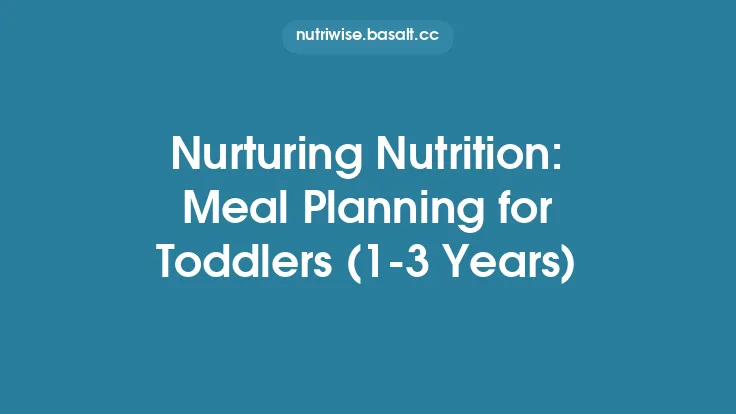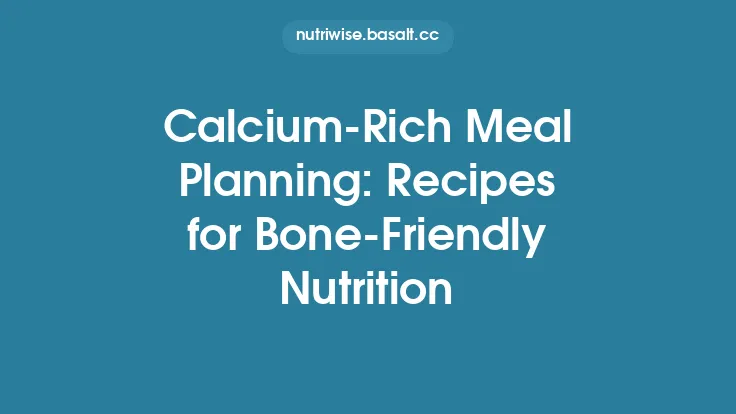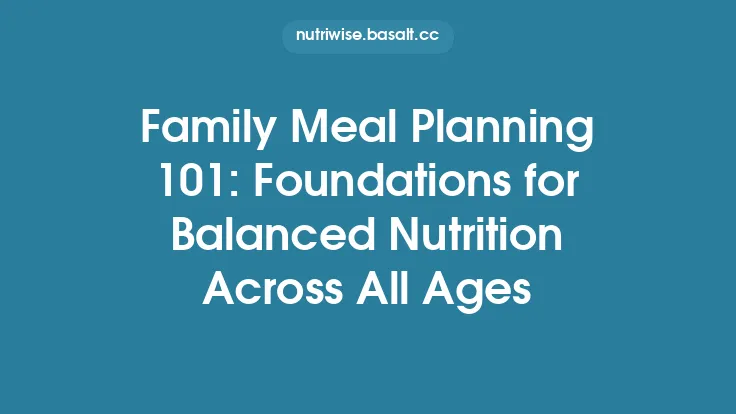In your 50s, you’re standing at a pivotal crossroads between the energetic demands of mid‑life and the more relaxed pace of retirement. Nutrition becomes a powerful lever you can pull to preserve muscle mass, support heart and brain health, maintain a healthy weight, and reduce the risk of chronic diseases that often surface later in life. Thoughtful meal planning isn’t just about counting calories; it’s about delivering the right mix of macro‑ and micronutrients at the right times, while fitting seamlessly into a busy schedule that may include work, family responsibilities, and the beginnings of a more active social life. Below is a comprehensive guide that walks you through the science, the practicalities, and the day‑to‑day tactics for building a sustainable, health‑promoting eating pattern tailored to adults in their 50s.
Understanding the Nutritional Landscape of the 50s
Metabolic Shifts
Basal metabolic rate (BMR) typically declines by about 2–5 % per decade after age 30. By the time you reach your 50s, you may notice that the same portion sizes that kept you fit in your 40s now lead to gradual weight gain. This isn’t solely a matter of “eating less”; it reflects reduced lean muscle mass, hormonal fluctuations, and changes in activity patterns.
Body Composition Changes
Sarcopenia—the age‑related loss of skeletal muscle—begins subtly in the 50s. Even a 5 % reduction in muscle mass can impair glucose regulation and increase fall risk. Counteracting sarcopenia requires adequate protein (≈1.0–1.2 g/kg body weight per day) combined with resistance‑type activities.
Cardiovascular and Metabolic Risk
Incidence of hypertension, dyslipidemia, and impaired glucose tolerance rises sharply in this decade. Diets rich in soluble fiber, omega‑3 fatty acids, and plant sterols have been shown to improve lipid profiles and blood pressure.
Bone Health
Peak bone mass is usually reached by the late 20s, after which a slow net loss occurs. By the 50s, calcium and vitamin D become critical to slow bone demineralization, especially for those who are not yet post‑menopausal but may be experiencing early hormonal shifts.
Cognitive Resilience
Emerging evidence links dietary patterns high in antioxidants, polyphenols, and omega‑3s with better preservation of executive function and memory. The Mediterranean and DASH (Dietary Approaches to Stop Hypertension) patterns are repeatedly associated with lower rates of mild cognitive impairment.
Building a Balanced Plate: The 50‑Year‑Old’s Blueprint
| Food Group | Recommended Daily Servings* | Key Benefits |
|---|---|---|
| Vegetables (non‑starchy) | 3–5 cups | Fiber, potassium, phytonutrients; blood pressure regulation |
| Fruits (whole) | 2–3 cups | Antioxidants, vitamin C, natural sweetness |
| Whole Grains | 5–6 oz equivalents | Complex carbs, B‑vitamins, sustained energy |
| Lean Protein (poultry, fish, legumes, low‑fat dairy, tofu) | 5–6.5 oz | Muscle maintenance, satiety, micronutrients (iron, B12) |
| Healthy Fats (nuts, seeds, olive oil, avocado) | 3–4 tbsp | Omega‑3s, monounsaturated fats, anti‑inflammatory |
| Dairy or Fortified Alternatives | 2–3 cups | Calcium, vitamin D, protein |
| Water | ≥8 cups (≈2 L) | Hydration, metabolic processes |
\*Servings are based on a 2,200–2,400 kcal reference intake, which aligns with the average energy needs of moderately active adults in their 50s. Adjust up or down according to personal activity level, body size, and goals.
Plate Method
- Half of the plate: colorful non‑starchy vegetables (leafy greens, cruciferous veg, peppers).
- Quarter: high‑quality protein (fish, poultry, legumes).
- Quarter: whole grains or starchy vegetables (sweet potato, quinoa).
- Side: a small portion of healthy fat (a drizzle of olive oil, a handful of nuts).
Key Nutrients to Prioritize
- Protein – Essential for muscle preservation. Aim for a protein source at each main meal; include dairy or plant‑based options for variety.
- Omega‑3 Fatty Acids – EPA and DHA (found in fatty fish, algae supplements) support heart rhythm, reduce triglycerides, and may protect cognitive function. Target 1–2 servings of fish per week.
- Fiber – Soluble fiber (oats, barley, legumes) helps lower LDL cholesterol; insoluble fiber (whole wheat, nuts) promotes gut motility. Goal: 25–30 g/day.
- Calcium & Vitamin D – Crucial for bone density. Combine calcium‑rich foods (low‑fat dairy, fortified plant milks, leafy greens) with safe sun exposure or a vitamin D supplement (800–1,000 IU/day, per physician guidance).
- Magnesium – Involved in over 300 enzymatic reactions, including blood pressure regulation. Sources: nuts, seeds, whole grains, legumes.
- Potassium – Counteracts sodium’s effect on blood pressure. Aim for 4,700 mg/day via fruits (bananas, oranges), vegetables (spinach, potatoes), and legumes.
- Vitamin B12 – Absorption declines with age; ensure intake through animal products or fortified foods, especially for vegetarians.
- Antioxidants (Vitamin C, E, polyphenols) – Combat oxidative stress linked to chronic disease. Emphasize berries, citrus, nuts, and dark chocolate (≤1 oz).
Managing Common Health Concerns Through Food
| Concern | Dietary Strategies | Sample Foods |
|---|---|---|
| Elevated Blood Pressure | Reduce sodium (<1,500 mg/day), increase potassium, adopt DASH‑style meals | Baked salmon, roasted beet salad, unsalted nuts |
| Pre‑diabetes / Blood Sugar Instability | Choose low‑glycemic carbs, pair carbs with protein/fat, spread intake across the day | Steel‑cut oats with almond butter, quinoa‑black bean bowl |
| Joint Discomfort | Anti‑inflammatory omega‑3s, antioxidants, limit processed meats | Sardines, chia seed pudding, turmeric‑spiced lentils |
| Weight Management | Emphasize volume foods (veg), control energy density, mindful portioning | Veggie‑laden stir‑fry with tofu, cauliflower “rice” bowls |
| Digestive Health | Adequate fiber, probiotic‑rich fermented foods, stay hydrated | Greek yogurt with kefir, kimchi, lentil soup |
Meal Planning Strategies That Stick
- Batch‑Cook Core Proteins
- Roast a tray of chicken breasts, bake salmon fillets, or simmer a pot of beans on Sunday. Store in portion‑size containers for quick assembly.
- Pre‑Portion Grains & Legumes
- Cook quinoa, brown rice, or farro in bulk; portion into freezer‑safe bags. This eliminates the “cooking from scratch” barrier on busy weekdays.
- Veggie‑First Prep
- Wash, chop, and store a mix of salad greens, bell peppers, carrots, and broccoli in airtight containers. Use them raw for snacks or quickly sauté for meals.
- Themed Meal Days
- Assign simple themes (e.g., “Mediterranean Monday,” “Fish Friday”) to reduce decision fatigue and ensure variety.
- Smart Grocery Lists
- Organize the list by store sections (produce, proteins, pantry, dairy) and include “core staples” (olive oil, spices, canned tomatoes) that rarely change.
- Seasonal Rotation
- Align produce choices with seasonal availability to maximize flavor, nutrient density, and cost‑effectiveness.
- Portion‑Control Tools
- Use a digital kitchen scale or measuring cups for the first few weeks to internalize appropriate serving sizes.
Sample Weekly Meal Plan (2,200 kcal)
Day 1
- *Breakfast*: Greek yogurt (170 g) with mixed berries, 1 tbsp chia seeds, and a drizzle of honey.
- *Snack*: Handful of almonds (¼ cup).
- *Lunch*: Quinoa salad with chickpeas, cucumber, cherry tomatoes, feta, and lemon‑olive oil dressing.
- *Snack*: Apple slices with 2 tbsp peanut butter.
- *Dinner*: Grilled salmon (5 oz) with roasted Brussels sprouts and sweet potato wedges.
Day 2
- *Breakfast*: Steel‑cut oats cooked in fortified soy milk, topped with sliced banana and cinnamon.
- *Snack*: Carrot sticks with hummus (¼ cup).
- *Lunch*: Turkey and avocado wrap in a whole‑grain tortilla, side of mixed greens with balsamic vinaigrette.
- *Snack*: Cottage cheese (½ cup) with pineapple chunks.
- *Dinner*: Stir‑fried tofu, broccoli, and bell peppers over brown rice; seasoned with ginger, garlic, and low‑sodium soy sauce.
Day 3
- *Breakfast*: Spinach‑mushroom omelet (2 eggs + 2 egg whites) with a slice of whole‑grain toast.
- *Snack*: Small orange and a few walnuts.
- *Lunch*: Lentil soup (1 cup) with a side salad (arugula, beetroot, goat cheese).
- *Snack*: Greek yogurt (½ cup) with a sprinkle of granola.
- *Dinner*: Baked chicken thigh (skinless) with quinoa pilaf and steamed asparagus.
*(Repeat or remix the pattern for the remaining days, ensuring at least two servings of fatty fish per week, three servings of legumes, and a daily variety of colorful vegetables.)*
Practical Tips for Everyday Success
- Cooking Methods Matter: Favor grilling, steaming, baking, and sautéing with minimal added fats. These techniques preserve nutrients and keep calorie density low.
- Hydration: Aim for 8–10 cups of water daily; herbal teas count. Limit sugary drinks and excessive caffeine, which can affect calcium balance.
- Mindful Eating: Put away screens, chew thoroughly, and pause between bites. This improves satiety cues and can prevent overeating.
- Smart Snacking: Pair a protein source with fiber (e.g., cheese + fruit, nuts + veggies) to stabilize blood sugar between meals.
- Supplement Caution: Use supplements only when dietary intake falls short (e.g., vitamin D in winter, B12 for vegans). Always discuss with a healthcare provider.
- Adjust for Activity Levels: On high‑intensity workout days, increase carbohydrate portions (e.g., an extra half‑cup of brown rice) and ensure post‑exercise protein (≈20–30 g).
Monitoring Progress and Making Adjustments
- Track Food Intake (1–2 weeks) using a reputable app or a simple journal. Look for patterns: Are you consistently hitting protein goals? Is sodium intake creeping above 1,500 mg?
- Measure Body Metrics quarterly—weight, waist circumference, and, if possible, body composition (lean mass vs. fat mass).
- Check Biomarkers annually: lipid panel, fasting glucose or HbA1c, blood pressure, and vitamin D levels. Use results to fine‑tune macronutrient ratios or add targeted foods (e.g., more soluble fiber for high LDL).
- Iterate: If you notice fatigue, consider increasing iron‑rich foods (lean red meat, lentils) or B‑vitamin sources. If joint soreness persists, boost omega‑3 intake or incorporate anti‑inflammatory spices like turmeric and ginger.
Resources and Tools to Keep You on Track
- MyPlate.gov – Interactive visual guide for portioning.
- USDA FoodData Central – Detailed nutrient database for precise tracking.
- Heart-Healthy Recipes – American Heart Association’s collection of low‑sodium, high‑fiber dishes.
- Meal‑Prep Apps (e.g., Mealime, Yummly) – Offer customizable weekly plans with grocery lists.
- Fitness Trackers – Pair activity data with nutrition logs for a holistic view of energy balance.
By integrating these evidence‑based principles into a realistic weekly routine, you can harness the power of food to safeguard heart, bone, and brain health while maintaining a vibrant, energetic lifestyle as you approach retirement. Consistency, variety, and a willingness to adapt are the cornerstones of a successful pre‑retirement meal plan—ingredients that, together with your own determination, will help you enjoy the next chapter with confidence and vitality.





